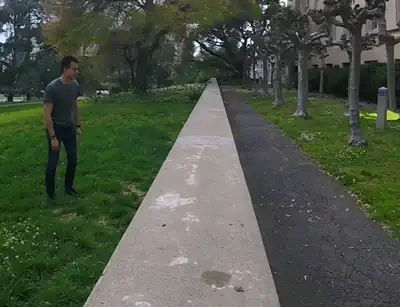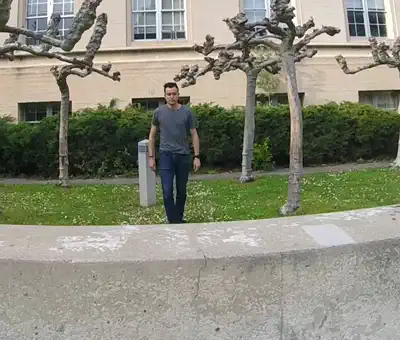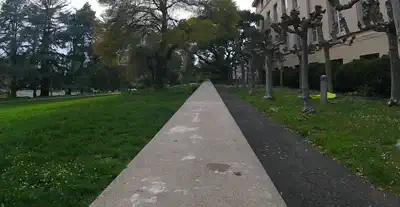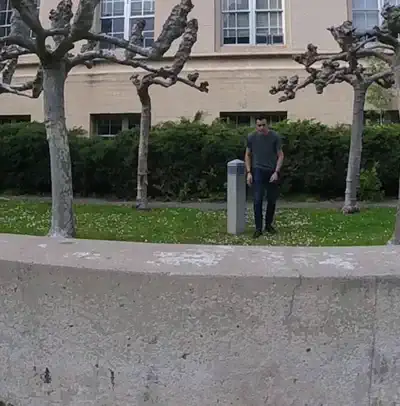Parkour is the art of moving between two points in the most efficient way possible. It’s a fun and free hobby, that’s more than just running and jumping around. It teaches you how to move your body and interact with your environment. One practical benefit of learning parkour, for me personally, is that I’m better able to catch myself when tripping or falling. One non-practical benefit is that I’m much better at tag.
I used to do a lot of parkour through SF Parkour/Cal Parkour back when I was at Berkeley. It’s still going on, though! Check out SFPK’s monthly jam which happens the third Sunday of every month! They also have good free beginner’s classes. At the time of writing (April 2023, and checked again in February 2024) I think Elaine is doing parkour every Wednesday at Doe Library at 5:30pm (see the event calendar).
Moves
There are different moves in parkour. “Vaults” are your most typical move, which involves getting over some barrier like a handrail or wall.
-
Vaults
-
Lazy vault

Me demonstrating a lazy vault… poorly. The most basic and practically useful vault for getting over handrails.
If you have a rail on your left side, you put your left hand on the rail, swing your left leg up and above the rail, followed by your right leg, and then use your right arm to push off the rail.
You can do this while walking.
-
Safety vault

A safety vault. I put my left hand on the wall, put my right foot on the wall, then step through with my left leg. Probably the first vault you learn to do. For a safety vault on your left side, place your left hand on the wall, then place your right leg on the wall, and then step through with your left leg.
This vault is pretty simple to do, doesn’t require any momentum, and there’s minimal chance of you hurting yourself. The “cons” of this vault is that it’s not very fast.
-
Speed vault

A basic speed vault. Put your hand on the wall, throw your legs to the side, and move through. Now, unlike what I did here, you’d normally keep running forward. And you’d probably be doing this a lot faster. This is like a safety, but if you never put your feet on the wall, only using your arm to touch the barrier.
-
Kong

Me demonstrating a kong vault. This is also kind of a poor example because I stutter step, and I’m not going terribly fast. But you get the idea. Kongs look like you’re flying. You run straight at an obstacle, jump, and use your arms outstretched in front of you to propel you over the barrier.
-
Dash

Me demonstrating a dash vault. I throw my legs in front of me, and my arms push off the wall behind me. Again, this isn’t a particularly clean example, and I hadn’t done dash vaults for years when I did this. A dash is the opposite of a kong. In a kong you had your legs trailing behind you. With a dash you have your legs leading ahead of you as you jump.
-
Monkey
Much slower than a kong. Instead of jumping over a barrier completely you just jump onto it.
-
Thief vault
This is basically like the lazy vault, but you swing your outside leg first before your inside leg.
I’m actually not sure if the thief vault has a practical benefit over the lazy vault, aside from maybe looking cooler. I don’t really use it much.
-
Reverse vault
This is like if you did the safety vault backwards. As a consequence, it’s probably less safe (but less safe = more cool! /s).
-
Gate vault
This is a weird vault. You basically place your stomach on a rail and throw your legs over. It’s not really a fast vault, but you might use it for getting over tall fences.
-
-
Wall run
You, uh, run up a wall. Presumably to climb it.
-
Tic-tac
A “tic-tac” (or just “tac”) is where you kick off a wall while airborne in order to go higher, further, or just to change directions.
-
Precision
A precision (or “pre”) is where you land “precisely” with two feet. For example, when jumping onto a rail, you might use a “precision”.
This can be the landing of another move. For example, you’ll hear the term “kong-pre” a lot, which just means doing a kong and then landing with a precision on some other object.
-
Crane
A crane is where you land with one leg on top of an object and your other leg dangles in front of it. You might crane onto a small wall.
-
Cat
When jumping to a wall, a cat is where you land with both feet against the wall and both hands grabbing the ledge.
-
Roll
Rolls are actually important for defusing large amounts of kinetic energy. Rolling as you land can help save your knees from handling a massive amount of impact.
-
Dive roll
The kind of vault you’d use to get over a hedge or other barrier you can’t really touch.
This movement involves jumping hands-first over a barrier, landing with one’s hands and rolling over their shoulder.
-
Quadrapedal Movement (“QM”)
QM is so-called because you move on “all-fours”. That is, you move around on your hands and feet.
QM is great for moving along thin objects, like railing, since QM can give more stability than walking and balancing on one’s feet. With QM your center of gravity is low.
The trick to QM is in the rhythm of your hands and feet, making sure to keep balance even as you move. To do this, when you move your left hand, you should move your right leg. When you move your right hand, move your left leg at the same time. Your outstretched limbs shouldn’t be on the same side, as this would give you no control to rebalance yourself. If your outstretched limbs are on opposite sides, you can balance yourself even with only one hand and leg on the ground.
-
Bar stuff (or things you might use on scaffolding)
-
Underbar
Grabbing onto a bar, you swing your legs and body underneath and through it. Maybe you’d use this to go under a rail, for example.
-
Lache
Swinging from one bar, letting go, and landing on another.
-
Progressions
Most moves are generally learned through progressions, where you start by doing part of a move (or a smaller move) and work your way up. For example, when learning the speed vault, you’d generally do safety vaults first and then gradually try not placing your leg on the wall. For learning kongs, you’d get comfortable with doing monkeys first, and then try doing kongs on shorter walls (the planters at Bechtel Terrace is a pretty good place in Berkeley for this) and then move to higher walls or longer walls.
Good spots to do parkour
(In the Bay Area)
-
Berkeley
-
Doe Library (map)
Doe Library has the best all-around parkour objects, in my opinion. The concrete rails separating the library and lawn are the perfect height and width for practicing vaults.
The concrete stairs on the northwest side of Doe Library are a good place to practice tic-tacs and wall runs. You can also QM along the concrete railing of the stairs.
- East Asian Library has good walls (map) for wallrunning
- Bechtel terrace (map) has some concrete planter boxes that are good for practicing reverses
- “Rail mountain” (map) is near Bechtel terrace, west of Davis Hall and downstairs. It is so-called because of the number of handrails near stairs. I’m not really a rail guy, but it’s a fun place nonetheless.
- The wall on the south side of Mulford Hall, sometimes called the “beginner’s wall” (map)
-
- San Francisco
Gear
Shoes
Having good shoes can be pretty helpful.
Characteristics to look for in shoes:
-
Is the sole flat?
- You want soles to be pretty flat. Shoes that have heels or bridges are harder to use for wall runs and precisions.
-
How flexible or soft are the shoes?
- This is a matter of taste. Softer shoes can make some precisions easier and may make your landings quieter. FiveTen brand shoes tended to be harder, making landings louder.
-
How grippy are the soles?
- Shoes with high-grip rubber will make it easier to do wall-runs, tacs.
- Don’t become over-reliant on high-tech shoes, though. One of my close friends could do wallruns as well (or better) than me, and he just used some beat-up Reeboks. What was more important was his technique.
The rock climbing shoe brand “FiveTen” used to make shoes dedicated for parkour. These shoes were pretty good for the amount of grip they had, letting you wall run a lot higher than normal shoes. But FiveTen stopped making parkour shoes sometime between 2012-2015. Their biking-focused shoes still work pretty well, having the same high-grip soles. They tend to be expensive, though. I mostly just used FiveTens.
Feiyue-brand shoes are also pretty popular, being flat, soft, flexible, and (importantly) cheap. I’m told they’re also popular for kung fu. My partner says they’re flexible, give good contact with the ground. They wear out quickly, but they’re cheap so it’s worth it.
I also know some people used “Ollo” brand shoes. My partner says, “they’re decent, but I feel like they tend to fall apart quickly.” But since they’re more expensive, it may be less worth it.
A couple people also tried Vibram.
Pants
The most popular type of pants to use are sweatpants. Sweatpants are cheap and loose, giving you a wide range of motion compared to what you’d normally wear on the street.
I never wore sweatpants, though, because of a different philosophy. My philosophy was one of ecological validity. If I wanted to use parkour in real life, I’d have to train in something I’d normally wear. Unfortunately, what I’d normally wear was cargo pants. Cargo pants were actually pretty good, in terms range-of-motion, but nobody told me I looked like an effing dweeb. 🤦
Philosophy
Historically, the philosophy of parkour was that it focused on the fastest way to get from point A to point B, and developing the skills to do that. I got the sense that parkour was primarily pragmatic. It wasn’t competitive and it wasn’t focused on aesthetics or flourishes like backflips. Not that you can’t do a webster flip if you wanted, but that was “free running”, not parkour.
The debate of “parkour vs free-running” was a point of contention for a while. But like so many things, you can’t keep any concept “pure” (whatever “pure” means anyway). Some people are going to do free-running and call it parkour. As a response, some people jokingly coined the term “rage froobling” to refer to an activity that was even more extreme and pure than parkour. Imagine a no-holds-barred scramble-fight to get to some destination. One game I remember with a friend is where we’d just chuck a tennis ball really far and scramble, push, and drag each other so one of us could get to it first. Rage froobling was supposed to be so extreme that only the truly dedicated practiced it, while the masses avoided it. Only the latter part holds today.
These days, parkour doesn’t feel as philosophical. Some people have competitions, some people do flips, some people hold classes in a padded indoor gym. In the end, as long as you have fun learning how to move your body through your environment, that’s probably parkour-enough for me.
Movies
Some of my favorite movies that feature parkour.
-
District 13 (Banlieue 13, Wikipedia) and the sequel District 13: Ultimatum
I originally saw the sequel—District 13: Ultimatum—in theatres, and I thought it was amazing. I was able to see the original through my university library.
What I like most about these two parkour movies is that parkour is the main tool the characters use. The characters don’t really fight much, they just need to get away. In other movies, like the newer James Bond films, parkour is just a transition between two different places.
Some of my not-favorite movies that feature parkour:
-
Bubble (2022)
An anime on Netflix that has parkour. But, it’s like, parkour over floating bubbles that have destroyed the world. And also it’s an anime so physics don’t have to make any sense at all. And also also the point of the anime isn’t even the parkour, it has to do with some weird magical girl that’s like a straight-up Little Mermaid rip-off because she:
- Doesn’t talk
- Falls in love with the main character
-
Spoiler
Basically turns into bubbles.
If you want to watch an anime with kids running around a cool city, maybe watch Tekkonkinkreet instead. Or maybe Kakurenbo.
